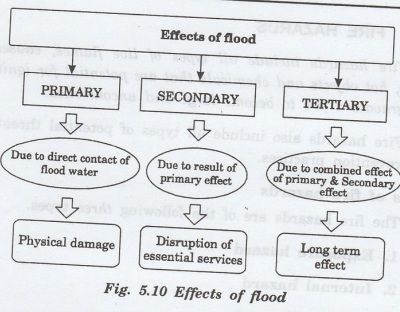Physics For Civil Engineering: Unit V: Natural Disasters
Flood Hazards
Definition, Factors resulting floods, Types, Causes, Methods of flood prevention
The accumulation of large quantity of water at a place or the flow of more water than that can be handled by the drainage of the area is known as flood.
FLOOD HAZARDS
Among the natural hazards, flood is the
most widespread.
The
accumulation of large quantity of water at a place or the flow of more water
than that can be handled by the drainage of the area is known as flood.
Factors resulting floods
The occurrence of flood at any
particular place depends on the
following factors.
•
Climatic conditions of the area
• Nature of the collecting basin
• Nature of the streams, soil and
vegetative cover
•
Rate of melting of snow,
• Amount of rainfall received.
Types of Floods
There
are '3' types of floods
(i)
Flash flood
(ii)
River flood
(iii)
Coastal flood

(i) Flash Floods
These
occur within hours of heavy rainfall. They are usually associated with towering
cumulus clouds, severe thunderstorms and tropical cyclones or the passage of
cold weather fronts.
Flash
floods may also be caused by dam failure or other river obstructions.
(ii) River Floods
River
floods are caused by precipitation over large catchment areas or by melting of
snow or sometimes both.
They take place in river systems with
tributaries that may Cover or drain large geographical areas. They involve many
independent river basins.
These
floods normally build up slowly and may continue for days or weeks as compared
to flash floods.
The
amount of flooding depends on factors such as ground conditions (moisture,
vegetation cover, and depth of snow) and size of the catchment basin.
(iii) Coastal Floods
Coastal floods are associated with the
cyclonic activities such as hurricanes, tropical cyclones, etc. They are often
aggravated by wind-induced storm surges along the coast.
Heavy
rains over a large geographic area produce extreme flooding in coastal river
basins, similar to river floods.
Causes of Floods
1.
Heavy
rain for a very short period result in floods.
2. River can overflow their banks to
cause flooding, as it flows downstream to the adjacent low lying areas.
3. Sea water can be carried by massive
winds & hurricanes on to dry coastal lands and cause flooding.
4. Excess of water held up in the dam
can cause it to break and overflow the area. Excess water can be released from
the dam to prevent it from breaking and that can also cause floods.
5. Heavy snow over the winter stays
unmelted for sometime. This ice suddenly melts when the temperature rises,
resulting in flow of water in to places that are dry. This is called snow melt flood.
Effects
of Flood Hazards
Floods can result devastating
consequences and effects on the economy.
Primary
hazards
Primary
hazards are the effects of floods due to direct To aysh Tol contact with the
flood waters.
•
With greater velocities, flood streams are able to carry larger objects such as
houses, bridges and automobiles.
•
Humans can get caught in the high velocity flood waters asitivi and can be
drowned in the water.
•
Floods can cause erosion, erosion can weaken bridges, and buildings causing
their collapse.
•
Flooding of farmland can result in loss of crop, livestock, pets and other
animals.
Secondary
Hazards
Secondary hazards are those that occur
because of primary
• Drinking water gets polluted if sewage treatment plants are
in the flooded area. This contamination can result in disease and other health
issues.
•
Transportation systems can be affected and as a result ed as food supplies and
aid can be delayed. This has resulted brain starvation even in developed
countries.
Tertiary or Long term Hazards
• Long term changes bua
•
Destruction of wildlife habitat.
•
Sediment deposited during flooding may leave farm land in poor condition.

Methods of flood prevention
The
intensity of flood can be minimized using the following measures.
Plantation on Slopes
Plantation
helps in regulating river flow and controls soil erosion.
Drainage Management
Improvement of channels by removing
debris and sediments helps in regulating the rate of river flow.
Floodplain Zoning
Flood
plains can be managed by dividing them into different temporal plots. This is
commonly referred to as flood-plain
zoning.
Forecasting
Possible damage can be minimized by
forecasting the occurrence of floods and warning the people about the possible danger.
Physics For Civil Engineering: Unit V: Natural Disasters : Tag: : Definition, Factors resulting floods, Types, Causes, Methods of flood prevention - Flood Hazards
Related Topics
Related Subjects
Physics for Civil Engineering
PH3201 2021 Regulation | 2nd Semester Civil Dept 2021 Regulation
